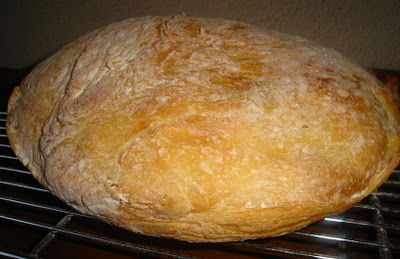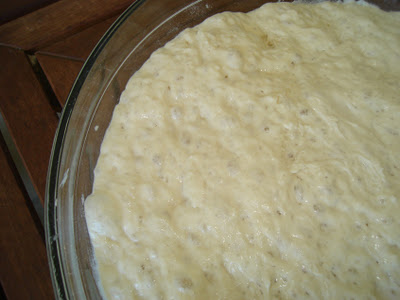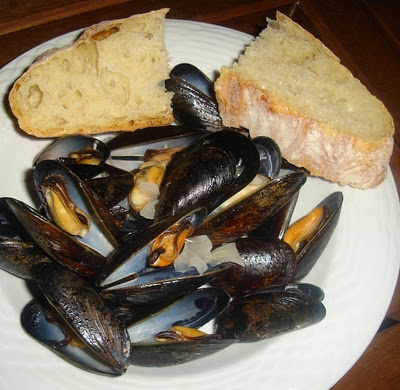No Knead to Freak Out--Part Two
As promised, I have pulled out the gloves (oven mitts, in this case) for a second round of No Knead Bread. When we last talked about my adventures with this bread, I left you with the thoughts that I had fallen in love with the overall appearance, crust, interior and crumb of this bread, but that the flavor left much to be desired. So I played a bit with the original recipe (which I have moved to a permanent position in this post) and was really pleased with the results. A single bare bite of this second attempt, with not even the slightest drizzle of olive oil pooling in its crevices, confirmed that this bread is definitely worth the hype. The added salt (an extra 1/2 teaspoon) this time around clearly gave the bread a new life and dimension and made for an even tastier crust.
More importantly, while the first loaf tasted of not much at all, this loaf was full of flavor, almost a Sourdough Lite, if you will--certainly the result of an extra eight hours tacked onto the first rise (for a total of 24 hours as opposed to 16 in the first attempt). I knew there would be some improvement this time around when I lifted the plastic wrap from the bowl after the first long rise and the vigorous bouquet of yeasty alcohol smacked me on the nose. Hooray!
After catching onto the smell wafting through the apartment during the baking of this loaf, my No Knead confidence was restored, and I quickly devised a dinner menu that would rely on what would surely be great bread to make it complete, lest you think I never eat anything other than baked goods. And so it had to be: a mountain of fresh, tender black Pacific mussels, steamed in a luscious broth of sauvignon blanc, butter, shallots and garlic, with a spritely green salad on the side. There really was just no other way around it.
So for me and my palate (and the husband's too, though he seemed to like the first loaf just fine as well...he is steadfast and true that way) this is the recipe for No Knead Bread that I will be using again and again.
No Knead Bread
Adapted from Jim Leahy of Sullivan Street Bakery, NYC and Chocolate and Zucchini
470 grams of all-purpose or bread flour (I used King Arthur Bread Flour)
2 1/2 teaspoons of salt (I used my favorite fleur de sel)
1/4 teaspoon instant yeast
350 grams water at room temperature
Extra flour or cornmeal for dusting
Whisk the flour, salt and yeast together in a large bowl. Stir in the water with a wooden spoon or your hands, until fully incorporated. The dough will feel stickier and wetter than other bread doughs and will come together in a shaggy-looking ball. Cover the bowl with plastic wrap and let it rest for 24 hours at room temperature (ideally about 70 degrees).
After this first rise, the dough will be doubled in volume and covered in little bubbles. Turn the dough out onto a well-floured surface (it will still seem wetter and looser than other bread doughs). For this step, I like to take my favorite huge cutting board, cover it in parchment, securing it with tape, and then flour the parchment like mad. Gently pull at the sides of the dough for a rectangle shape, and then fold it into the thirds, with the two sides pulled towards the center. Give the dough a quarter turn and then fold into thirds again. Turn the dough over and shape into a ball. Cover the ball with plastic wrap and let it rest for 15 minutes. In the meantime, clean the bowl and lightly grease it. Put the dough back into the bowl, cover with plastic and let it rise a second time, for 2 hours.
30 minutes before the second rise is complete, preheat the oven to 450 degrees, with the dutch oven inside of it. When the second rise is complete, CAREFULLY remove the screaming hot pot from the oven and remove the lid. Sprinkle the inside of the pot generously with flour or cornmeal. Place the dough inside the hot pot, sprinkle with more flour or cornmeal, and replace the cover.
Bake at 450 degrees for 30 minutes with the lid, then remove the lid and bake for 15 minutes more, until the crust is so beautiful you almost begin to weep. Carefully remove the hot pot and turn the bread out onto a cooling rack. Let the bread cool for AT LEAST 45 minutes before slicing. The water needs to redistribute itself throughout the bread, so if you don't wait to cut it, the crumb will be rubbery, and after all that work, you don't want to risk that, do you?


